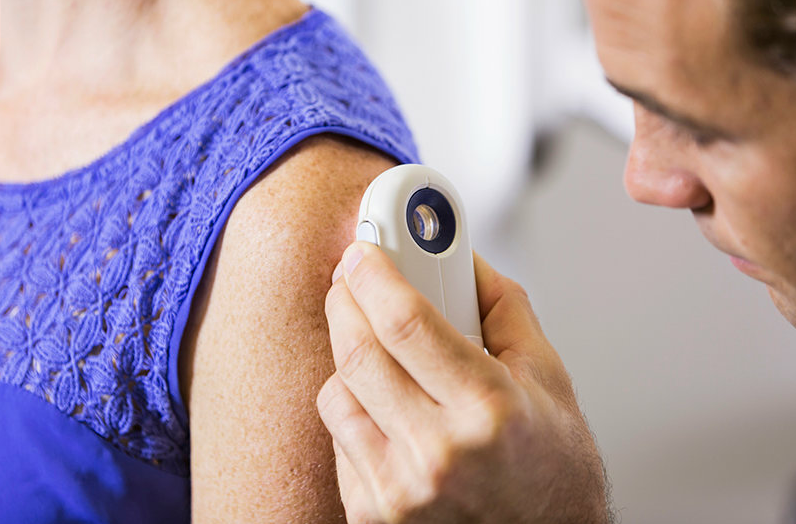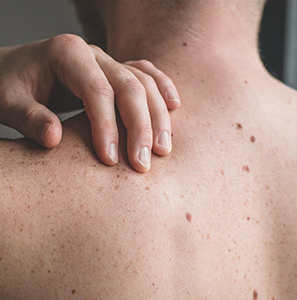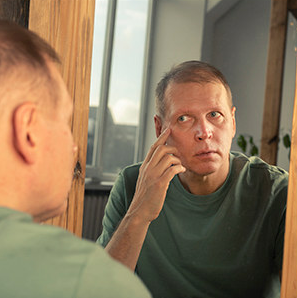Skin Cancer: Know the Signs

Skin cancer is the most prevalent type of cancer – more common in the US than all other cancers combined. Approximately one in five Americans will develop skin cancer by age 70 – and an average of two people die from skin cancer every hour in the US. But skin cancer is very treatable, especially when it’s detected early.
You can help find the three main kinds of skin cancer – melanoma, basal cell carcinoma, and squamous cell carcinoma – in its early stages by checking your skin each month. Routine monthly skin checks, in addition to a more thorough checkup with a healthcare provider as needed, is the best way to find new marks, sores, or skin changes. Follow the tips below to check your skin.
Skin cancer: are you at risk?
Anyone of any skin color can get skin cancer. But you're at greater risk if you have the following:
- Fair skin that freckles easily and burns instead of tanning
-
Light-colored or red hair
- Light-colored eyes
- Many moles or abnormal moles on your skin
- A long history of unprotected exposure to sunlight or tanning beds
- A history of many blistering sunburns as a child or teen
- A family history of skin cancer
- You’ve been exposed to radiation or chemicals
- A weakened immune system
- You’ve been exposed to arsenic
- A personal history of skin cancer
Regardless of your personal risk, everyone should perform at-home skin exams. Ask your primary care provider how often you should have a skin exam performed as part of your annual wellness exams – and whether you need a referral to a dermatologist.
How to check for skin cancer
Do your monthly skin checkups in front of a full-length mirror, ideally after a shower or bath. Use a room with good lighting so it's easier to see. Use a hand mirror to look at hard-to-see places like your buttocks and back. You can also have a trusted friend or family member help you with these checks. Check every part of your body, including your:
- Head (ears, face, neck, and scalp – use a blow dryer so you can see your scalp more clearly)
- Torso (front, back, sides, and under breasts)
- Arms (tops, undersides, and armpits)
- Hands (palms, backs, and fingers, including under the nails)
-
Lower back, buttocks, and genitals
- Legs (front, back, and sides)
- Feet (tops, soles, toes, including under the nails, and between toes)
Watch for new spots on your skin or a spot that's changing in color, shape, and/or size.
If you have a lot of moles, take digital photos of them each month. Make sure to take photos both up close and from a distance. These can help you see if any moles change over time.
What to look for: melanoma
Though not as common as the other types of skin cancer, melanoma is the most dangerous type of skin cancer, since it’s more likely to grow and spread to other organs if not treated early. You can check your moles or growths for signs of melanoma using ABCDE:
| Asymmetry | 
| The sides of the mole or growth don’t match. |
| Border | 
| The edges are ragged, notched, or blurred. |
| Color | 
| The color within the mole or growth varies. It could be black, brown, tan, white, or shades of red, gray, or blue. |
| Diameter | 
| The mole or growth is larger than ¼ inch or 6 mm (the size of a pencil eraser). |
| Evolving | 
| The size, shape, texture, or color of the mole or growth is changing. |
What to look for: other types of skin cancer
Although the more common nonmelanoma skin cancers are not as pervasive, they are still just as deadly when they develop undetected. Basal cell carcinoma (BCG) and squamous cell carcinoma (SCG) cause symptoms such as:
- A spot or mole that looks different from all other marks on your skin
- Changes in how an area feels, such as itching, tenderness, or pain
- Changes in the skin's surface, such as oozing, bleeding, or scaliness
- A sore that isn’t healing
- New swelling, redness, or spread of color beyond the border of a mole
Know your skin
Most skin changes aren't cancer. But if you see any changes in your skin, call your healthcare provider right away. Only they can tell you if a change is a problem. If you do have skin cancer, seeing your provider can be the first step to getting the treatment that could save your life.
Prevent Sun Exposure… Prevent Skin Cancer!

If you’re focused on your health, you likely avoid common carcinogens (cancer-causing agents) found in things like cigarettes and processed meats. But sun exposure – namely ultraviolet (UV) rays – is by far the most prevalent cause of the most prevalent cancer: skin cancer.
Even in northern Michigan, the UV index can get quite high, making exposure highly probable – especially since we tend to soak up the sun so much in the beautiful summer months. If you’re prone to sunburns, you’re at a higher risk of developing skin cancer. And even if you don't burn, you should be applying a broad-spectrum sunscreen with an SPF of at least 15 (30+ for extended outdoor activity). Click on the button below for more helpful tips to keep your skin healthy while you enjoy the long summer days.
Find a Skin Doc
Need a skin expert to inspect a mole or other skin condition you’re concerned with? Use our Find a Doc services to locate a dermatologist near you.

